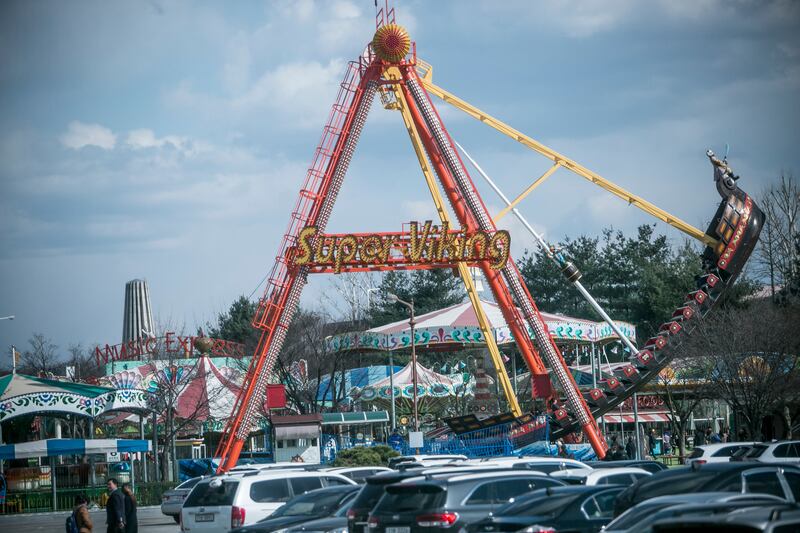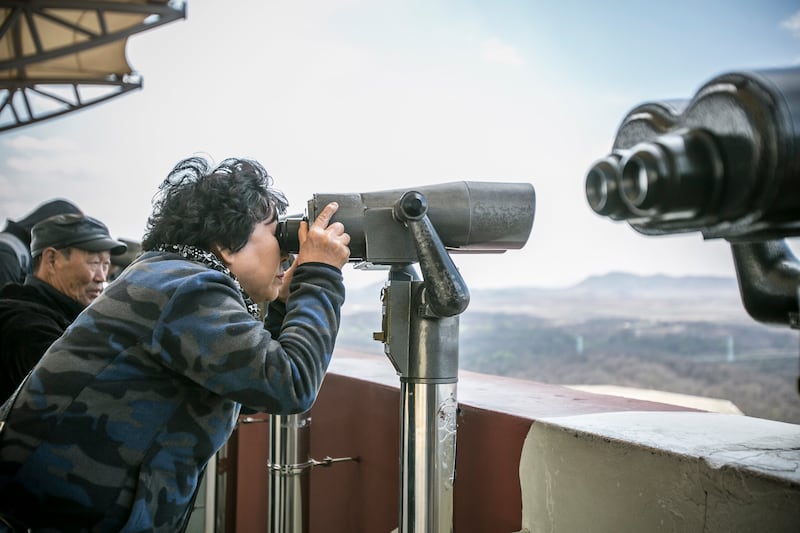Earlier this year I spent some time in South Korea. By definition, you cannot be in South Korea without thinking of Kim Jong-un’s authoritarian state to the north.
The “must-do” trip that’s widely advertised in Seoul is a day tour to the DMZ – the demilitarised buffer zone that separates North Korea from South Korea. It’s 250km long and four kilometres wide: the most heavily fortified and protected border in the world.
I hesitate before handing over $60 for this bus trip, struggling with the fact that I am paying money to basically go and gawk at a border beyond which we know millions of people are living under an unstable dictatorship. It seems unethical. As if these North Korean citizens are in some kind of horrible human zoo, and I am paying to look at them – money they will never benefit from.
In the end, my own curiosity wins out over my discomfort. I pay up.
RM Block
I board the bus at 7.30am on a Seoul street in a flurry of early February snow. The process to enter that two-mile buffer zone is exhaustive. We have been instructed to bring passports with us. There is a quota of people who can enter each day, and they are counted in and out four times: twice going in and twice coming out. The guide on our bus collects the passports and stops at the first checkpoint. There she receives a time for our group to spend our 30 minutes at the border: 11am.
Our passports are returned, and a sheet is passed around the bus with our names and nationalities. We are each given a number. At the next checkpoint, armed soldiers come on and check the names on the list against each person in a seat.

To fill the time until our allocated 11am slot, we visit a couple of other locations en route associated with the history of the creation of the border. One contains a funfair on its ground, with a carousel and various rides. Everything is closed, as it is still winter. Of all the things I think I might see at the North-South Korean border, swing boats and a merry-go-round for children are not among them. As I look at the funfair, we hear explosions in the distance. I record the sound on my phone, and when I play it back later, they do not sound all that distant.
Our bus goes through yet more checkpoints in territory totally empty of any construction except for huts with soldiers and army bases
There is more of the unexpected. There are fully-stocked DMZ gift shops. Along with the T-shirts, mugs and badges, there were also framed pieces of “limited edition” barbed wire used as part of a former iteration of the border. “Genuine!” Our guide assures us. “Fake in other places, but genuine barbed wire at the official DMZ gift shops.”
There is DMZ Chocolate in three flavours of black bean. There are bottles of a red wine called 38 Wine, whose label reads: “38th Parallel – The war began here, June 25th, 1950”. The bottles come with red and gold gift boxes. There is a handwritten label stuck on the shelf where the bottles stand. “Wine made by defector in a North Korean way!”
What is the most tasteless and disturbing part? The exclamation point? The fact the wine exists? Are you meant to eat one of the three different DMZ chocolate types with it? There is more: toy models of soldiers, sold in pairs, one in South Korean uniform and one in North Korean. There are DMZ branded shot glasses. There are replicas of life-size rifles in gold plastic, and a wide range of tiny metal pistol keyrings.
At one stop you can go down the extremely steep and deep “Third Tunnel” the North Koreans dug in the past. We are given helmets, and during our descent, we pass a number of gas masks behind glass, with an axe beside them, in case of what event I do not know. Poison gas? At the end of the tunnel, we are greeted by a sign informing us we are now only 170m from the border.
After the gift shops and the tunnel and the faded-looking sign in pink, green and blue you see in all the that spells out DMZ in huge letters, and which most tourists climb on top of to photograph each other, it is 11am and our slot at the edge of the two-mile buffer zone.
Of all the creepy experiences that morning, this is the creepiest. Our bus goes through yet more checkpoints in territory totally empty of any construction except for huts with soldiers and army bases. We take a road that curves steeply upwards; a hill that has been turned into an eyrie lookout for us paying tourists. Small red signs by the roadside flash past at intervals. I see one clearly when we stalled at a bend. “Mine.”
At the hillside lookout, called the Dora Observatory, I spent the entirety of my 30 minutes alternately staring through poor-quality binoculars and telescopes on the viewing platform, and squinting though the pale, severely cold and grey morning into North Korea. It is surreal. Bizarre. Sad. Horrible. Fascinating. Terrifying. I feel voyeuristic to be there, and ashamed.
There are two flags clearly visible, a kilometre or so apart on that flat terrain, on immensely tall flagpoles. The one nearest me is the flag of South Korea. The more distant one is North Korea. The border lies between the two flags. Beyond the North Korean flag, I can clearly see a building with all its windows blown out: a former factory that was the recent target of a strike from South Korea. I can see apartment blocks in the first city on the other side of the border, where people are living lives I cannot imagine.

Our guide tells us, while laughing, that until recently the two sides used to blast music nonstop at each other. The South side played K-Pop. The North played military music. I can’t recall her explanation as to why it stopped.
Why does she think we need to be entertained? The laughter seems to be normalising a situation that is not normal.
Most of my fellow guests from the bus take selfies or group shots on the viewing platform, with the terrible border and the two flags in the background, all of them grinning widely for the camera, some with thumbs up.
I am still thinking about that day, and still trying to figure out why.
























